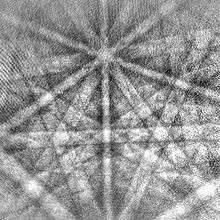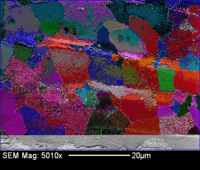Electron backscatter diffraction
Electron backscatter diffraction (EBSD) is a scanning electron microscope–based microstructural-crystallographic characterization technique commonly used in the study of crystalline or polycrystalline materials.[1][2] The technique can provide information about the structure[3], crystal orientation [3], phase[3], or strain[4] in the material. Traditionally these types of studies have been carried out using X-ray diffraction (XRD), neutron diffraction and/or electron diffraction in a Transmission electron microscope.


Geometry
For an EBSD measurement a flat/polished crystalline specimen is placed in the SEM chamber at a highly tilted angle (~70° from horizontal) towards the diffraction camera, to increase the contrast in the resultant electron backscatter diffraction pattern. The phosphor screen is located within the specimen chamber of the SEM at an angle of approximately 90° to the pole piece and is coupled to a compact lens which focuses the image from the phosphor screen onto the CCD camera. In this configuration, some of the electrons which enter the sample backscatter and may escape. As these electrons leave the sample, they may exit at the Bragg condition related to the spacing of the periodic atomic lattice planes of the crystalline structure and diffract. These diffracted electrons can escape the material and some will collide and excite the phosphor causing it to fluoresce.
Inside the SEM, the electron beam is focussed onto the surface of a crystalline sample. The electrons enter the sample and some may backscatter. Escaping electrons may exit near to the Bragg angle and diffract to form Kikuchi bands which correspond to each of the lattice diffracting crystal planes. If the system geometry is well described, it is possible to relate the bands present in the diffraction pattern to the underlying crystal phase and orientation of the material within the electron interaction volume. Each band can be indexed individually by the Miller indices of the diffracting plane which formed it. In most materials, only three bands/planes which intersect are required to describe a unique solution to the crystal orientation (based upon their interplanar angles) and most commercial systems use look up tables with international crystal data bases to perform indexing. This crystal orientation relates the orientation of each sampled point to a reference crystal orientation.
While this 'geometric' description related to the kinematic solution (using the Bragg condition) is very powerful and useful for orientation and texture analysis, it only describes the geometry of the crystalline lattice and ignores many physical processes involved within the diffracting material. To adequately describe finer features within the electron beam scattering pattern (EBSP), one must use a many beam dynamical model (e.g. the variation in band intensities in an experimental pattern does not fit the kinematic solution related to the structure factor).
EBSD Detectors
Experimentally EBSD is conducted using a SEM equipped with an EBSD detector containing at least a phosphor screen, compact lens and low light CCD camera. Commercially available EBSD systems typically come with one of two different CCD cameras: for fast measurements the CCD chip has a native resolution of 640×480 pixels; for slower, and more sensitive measurements, the CCD chip resolution can go up to 1600×1200 pixels. The biggest advantage of the high-resolution detectors is their higher sensitivity and therefore the information within each diffraction pattern can be analysed in more detail. For texture and orientation measurements, the diffraction patterns are binned in order to reduce their size and reduce computational times. Modern CCD-based EBSD systems can index patterns at up to 1800 patterns / second. This enables very rapid and rich microstructural maps to be generated. Recently, CMOS detectors have also been used in the design of EBSD systems. The new CMOS-based systems permit pattern indexing faster than CCD-based predecessors. Modern CMOS-based EBSD detectors are capable of indexing patterns up to 3000 patterns / second.
Indexing
Often, the first step in the EBSD process after pattern collection is indexing. This allows for identification of the crystal orientation at the single volume of the sample from where the pattern was collected. With EBSD software, pattern bands are typically detected via a mathematical routine using a modified Hough transform, in which every pixel in Hough space denotes a unique line/band in the EBSP. The Hough transform is used to enable band detection, which are difficult to locate by computer in the original EBSP. Once the band locations have been detected it is possible to relate these locations to the underlying crystal orientation, as angles between bands represent angles between lattice planes. Thus when the position / angles between three bands are known an orientation solution can be determined. In highly symmetric materials, typically more than three bands are used to obtain and verify the orientation measurement.
There are two leading methods of indexing performed by most commercial EBSD software: triplet voting; and minimising the 'fit' between the experimental pattern and a computationally determined orientation. A best practice guide for reliable data acquisition has been written by Professor Valerie Randle[5]
Triplet voting involves identifying multiple 'triplets' associated with different solutions to the crystal orientation; each crystal orientation determined from each triplet receives one vote. Should four bands identify the same crystal orientation then four (four choose three) votes will be cast for that particular solution. Thus the candidate orientation with the highest number of votes will be the most likely solution to the underlying crystal orientation present. The ratio of votes for the solution chosen as compared to the total number of votes describes the confidence in the underlying solution. Care must be taken in interpreting this 'confidence index' as some pseudo-symmetric orientations may result in low confidence for one candidate solution vs. another.
Minimising the fit involves starting with all possible orientations for a triplet. More bands are included that reduces the number of candidate orientations. As the number of bands increases, the number of possible orientations converge ultimately to one solution. The 'fit' between the measured orientation and the captured pattern can be determined.
Pattern centre
In order to relate the orientation of a crystal, much like in X-ray diffraction, the geometry of the system must be known. In particular the pattern centre, which describes both the distance of the interaction volume to the detector and the location of the nearest point between the phosphor and the sample on the phosphor screen. Early work used a single crystal of known orientation being inserted into the SEM chamber and a particular feature of the EBSP was known to correspond to the pattern centre. Later developments involved exploiting various geometric relationships between the generation of an EBSP and the chamber geometry (shadow casting and phosphor movement).
Unfortunately each of these methods are cumbersome and can be prone to some systematic errors for a general operator. Typically they can not be easily used in modern SEMs with multiple designated uses. Thus most commercial EBSD systems use the indexing algorithm combined with an iterative movement of both crystal orientation and suggested pattern centre location. Minimising the fit between bands located within experimental patterns and those in look up tables tends to converge on the pattern centre location to an accuracy of ~0.5–1% of the pattern width.
Orientation mapping


EBSD can be used to find the crystal orientation of the material located within the incident electron beam's interaction volume. Thus by scanning the electron beam in a prescribed fashion (typically in a square or hexagonal grid, correcting for the image foreshortening due to the sample tilt) results in many rich microstructural maps.
These maps can spatially describe the crystal orientation of the material being interrogated and can be used to examine microtexture and sample morphology. Some of these maps describe grain orientation, grain boundary, diffraction pattern (image) quality. Various statistical tools can be used to measure the average misorientation, grain size, and crystallographic texture. From this dataset numerous maps, charts and plots can be generated.
From orientation data, a wealth of information can be devised that aids in the understanding of the sample's microstructure and processing history. Recent developments include understanding: the prior texture of parent phases at elevated temperature; the storage and residual deformation after mechanical testing; the population of various microstructural features, including precipitates and grain boundary character.
Integrated EBSD/EDS mapping
When simultaneous EDS/EBSD collection can be achieved, the capabilities of both techniques can be enhanced. There are applications where sample chemistry or phase cannot be differentiated via EDS alone because of similar composition; and structure cannot be solved with EBSD alone because of ambiguous structure solutions. To accomplish integrated mapping, the analysis area is scanned and at each point Hough peaks and EDS region-of-interest counts are stored. Positions of phases are determined in X-ray maps and measured EDS intensities are given in charts for each element. For each phase the chemical intensity ranges are set to select the grains. All patterns are then re-indexed off-line. The recorded chemistry determines which phase / crystal structure file is used for indexing of each point. Each pattern is indexed by only one phase and maps displaying clearly distinguished phases are generated. The interaction volumes for EDS and EBSD are significantly different (on the order of micrometers compared to tens of nanometers) and the shape of these volumes using a highly tilted sample may have implications on algorithms for phase discrimination.
EBSD when used together with other in-SEM techniques such as cathodoluminescence (CL), wavelength dispersive X-ray spectroscopy (WDS) and/or energy dispersive X-ray spectroscopy (EDS) can provide a deeper insight into the specimen's properties. For example, the minerals calcite (limestone) and aragonite (shell) have the same chemical composition – calcium carbonate (CaCO3) therefore EDS/WDS cannot tell them apart, but they have different microcrystalline structures so EBSD can differentiate between them.
References
- Randle, Valerie; Engler, Olaf (2000). Introduction to texture analysis: macrotexture, microtexture and orientation mapping (Digital printing 2003 ed.). Boca Raton: CRC Press. ISBN 978-9056992248.
- Schwartz, A. J.; Kumar, M.; Adams, B. L.; Field, D. P. (2000). Electron backscatter diffraction in materials science. New York: Kluwer Academic.
- Electron backscatter diffraction in materials science (2nd ed.). Springer Science+Business Media. 2009. p. 1. ISBN 978-0-387-88135-5.
- Wright, Stuart I.; Matthew, M. Nowell; David, P. Field. (2011). "A review of strain analysis using electron backscatter diffraction". Microscopy and Microanalysis. 17. 17 (3): 316–329. Bibcode:2011MiMic..17..316W. doi:10.1017/S1431927611000055. PMID 21418731.
- Randle, Valerie (1 September 2009). "Electron backscatter diffraction: Strategies for reliable data acquisition and processing". Materials Characterization. 60 (9): 913–922. doi:10.1016/j.matchar.2009.05.011.